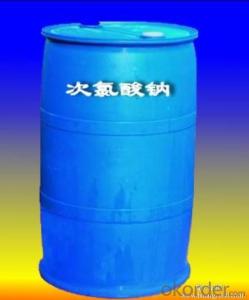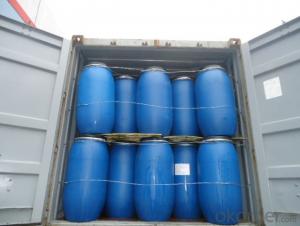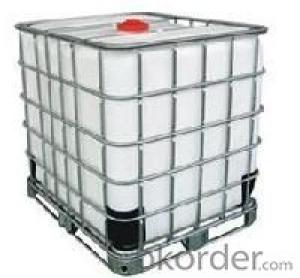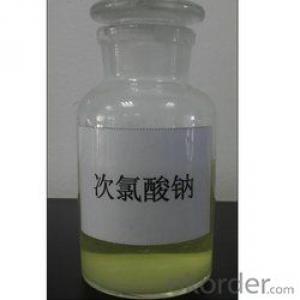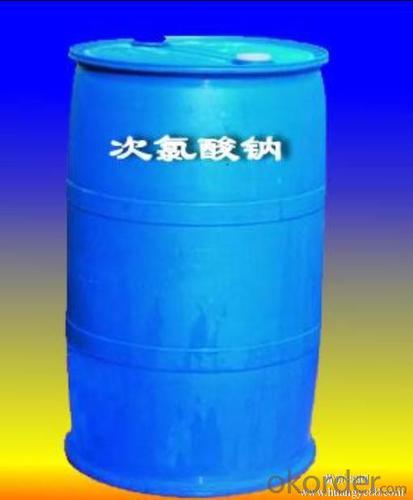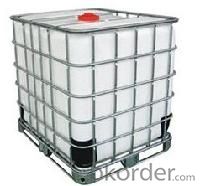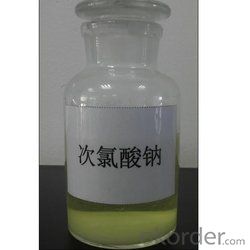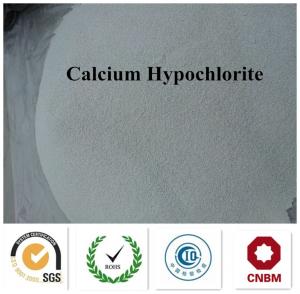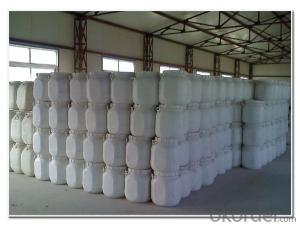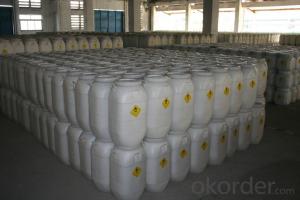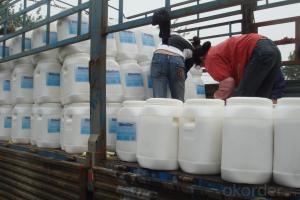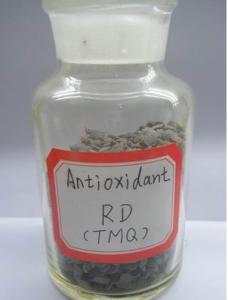Sodium Hypochlorite For Water Treatment
- Loading Port:
- Tianjin
- Payment Terms:
- TT OR LC
- Min Order Qty:
- 25 m.t.
- Supply Capability:
- 6000 m.t./month
OKorder Service Pledge
OKorder Financial Service
You Might Also Like
Sodium Hypochlorite
CAS NO: 7681-52-9
Chemical Formula: NaClO
Molecular Weight: 74.44
Appearance: Yellow transparent Liquid
Standard: HG/T2498-1993
Specification:
Available Chlorine: 8%-16%
NaOH: 1% Max
Transportation Info:
Class: 8 UN NO: 1791 PG:III
Application:
Disinfection for swimming pool, drinking water, cooling tower and sewage and waste water, food, and farming, hospital, school, station and household etc
Good bleaching and oxidation in paper and dye industry.
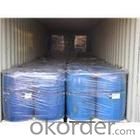
Normal Packing: 30kg drum, 1200kg IBC Tank
Usage
Used in the water the purification, as well as made the disinfectant, the paper pulp to float waits in vain, in the pharmaceutical industry used the system chloramine and so on.
Why choose us
· 7 years golden supplier for chemicals products
· One of leading chamicals export and import in china
· Large storage in Tianjin port ,china and work with many brother manufacturers
· Total solution for chemicals in china,more products are upgrade
· ISO9001 is approval with high quality
· Free sample and E-catalogue /TS/SDS are available
· 7*24Hr after-sevrice,reply within 1Hr for the emrgency in the working time.
- Q: Does the catalyst participate in chemical reactions?
- In fact, my understanding is to participate in the reaction, but in the whole process of reaction is both a reactant and a product. But in the reaction process is to participate.
- Q: No one knows the expression of the catalyst and the chemical expression of the acridine
- If it is potassium permanganate oxygen, the catalyst is only manganese dioxide, so write on the horizontal line MnO2
- Q: Are biological enzymes harmful to humans?
- A biological enzyme is a biocatalyst that is produced or extracted from a biological organism. The catalyst is a substance that accelerates the chemical reaction and does not change itself in the chemical reaction. In layman's terms, the catalyst is a special substance that catalyzes it. Enzyme as a member of the catalyst family has its own special properties. Each of the biological enzymes will only selectively react to some chemical reactions. A biological enzyme is equivalent to a key that opens a complex compound whose importance is that its unique structure or multidimensional shape matches a part of the group. Once these two parts are combined, the specific chemical bond in the group molecule changes as if the lock was opened. When the reaction is completed, the enzyme is released and repeated with the next group, followed by repeated repeats. Many chemical reactions in the normal temperature conditions, the reaction is very slow so that the whole process is difficult to be perceived.
- Q: Also, how is the catalyst affected by heat? Please answer all of the questions not just one of the three. THANK YOU!
- The catalyst is affected by vinegar because vinegar is acidic meaning there are more H+ ions. This alters the charges on the R groups of the amino acid residues of the enzyme molecule. The bonds that help maintain the conformation of the enzyme molecule which is ionic will therefore, be disrupted and the binding of substrate will be affected. However, if pH is restored to optimum pH, the maximum activity of the enzyme will be restored but this is only if the pH was only altered by a small extent. If pH is altered by a large extent, the conformation of the enzyme molecule will be severely affected causing it to denature. The catalyst is affected by heat because excessive heat disrupts the intermolecular bonds which stabilise the secondary and tertiary structure of an enzyme molecule(the enzyme molecule has a tertiary structure). The enzyme molecule unfolds and the precise shape of the active site is lost. This loss of structure and function is irreversible.
- Q: 1. Catalysts can help to bring the reactants together in the correct orientation2. The chemical formula of a catalyst is written on the left hand side (reactant) side of an equation.3. Catalysts can provide a surface on which the reaction occurs.4. Catalysts increase the activation energy.5. Catalysts increase the magnitude of the equilibrium constant, thus favoring product formation.6. "Enzymes" are biochemical catalysts.7. Catalysts increase the rate of a reaction.8. Catalysts are slowly used up during the reaction and need to be replaced.
- 1. Catalysts can help to bring the reactants together in the correct orientation False. It provides an alternative pathway (of lower activation energy) for reaction to occur. 2. The chemical formula of a catalyst is written on the left hand side (reactant) side of an equation. False. Written on the arrow that show the reatctants becoming products. 3. Catalysts can provide a surface on which the reaction occurs. True. For instance platinium in the case of hydrogenation of alkenes.
- Q: In the catalyst and light conditions to break down the water to get the chemical equation of hydrogen
- 2H2O = (light or catalyst) 2H2 ↑ + O2 ↑
- Q: I think doubling the concentration of catalyst will double the rate of a reaction (K2/K1 =2). I want to confirm. This is for my project work. Please reply as soon as possible.
- A catalyst speeds up a chemical reaction by providing an alternate reaction pathway with a lower activation energy, thus increasing the number of collisions that can result in the formation of product. When the catalyst is a reactant in the rate determining step, and the reaction is first order in the catalyst, then a doubling of the concentration will double the rate. But if the rate determining step which includes the catalyst is not first order, then doubling the concentration won't double the rate. Then there is the case of a heterogeneous catalyst in which the reaction is essentially zero order in the catalyst. The amount of catalyst won't affect the speed of the reaction beyond the initial increase. The mere fact that the catalyst is present speeds up the reaction.
- Q: Does anybody have any tips or references I can go to for this? I'm writing a novel and the main character wants to be a catalyst; the story isn't about him and his journey, so much as the effects on everyone around him that come about simply because of him being there and being who he is. How would I go about doing this, and doing it well?
- Ways to be a catalyst: By his behaviour: - He is a good listener. People use him as a sounding board and make important decisions as a result. - He is indiscreet and inadvertently reveals people's secrets and back-sniping comments. - He is a ****-stirring gossip. - He is a home-wrecking Lothario. - He is wise and gives good advice. - He is a hooligan who ruins businesses with vandalism, costs people their jobs and ruins relationships by beating people up. - He is a manipulative, blackmailing bastard who tries to turn every woman into a prostitute and con every man out of his money. - He is a charlatan who preaches nonsense about religion, health and business investments. By effortlessly influencing other people's behaviour: - He is famous and people try to impress him wherever he goes. - He has cancer or a disabling war wound. People admire and pity him and are shocked by his PTs mood wings. - He is gay, Muslim or a suspected paedophile and people want to persecute or cure him. - He is destitute. People argue amongst themselves over whether it's because he's lazy, has bad karma or there but for the grace of God go I. - He really looks like Jesus, Buddha or Santa and the sight of him makes people contemplate their Humanist values, coming to various conclusions. Perhaps you can write about his reputation; how he earned it, how it precedes him and provokes prejudices that he sometimes confirms or disproves. Use a detached, omniscient God-narrator. (Pretend Morgan Freeman's reading the audiobook.) Alternatively perhaps he is not a catalyst but a neurotic voyeur, fascinated by the minutiae of other people's lives so that the mundane appears tumultuous. He is not influencing people but your account of the changes in people's lives are centred on his observation of them.
- Q: What is the difference between a catalyst and an inducer in a chemical reaction?
- The catalyst does not participate in the reaction, but only the carrier of the reaction; the inducer will participate in the reaction
- Q: Is there a catalyst for a chemical reaction?
- There may be many, but some of the catalytic effect of the catalyst is good, and perhaps some of the catalyst has not been found
Send your message to us
Sodium Hypochlorite For Water Treatment
- Loading Port:
- Tianjin
- Payment Terms:
- TT OR LC
- Min Order Qty:
- 25 m.t.
- Supply Capability:
- 6000 m.t./month
OKorder Service Pledge
OKorder Financial Service
Similar products
Hot products
Hot Searches
Related keywords
